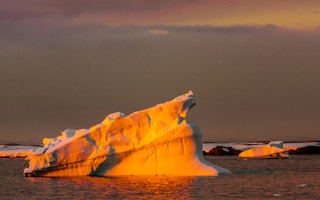New research on the effects of ice sheet melt in the Antarctic shows climate change is deforming the Earth’s crust, potentially prompting volcanic activity that could cause global sea-levels to rise much more than predicted.
Scientists led by Newcastle University in the UK studied the impact of the collapse of the giant Larsen B ice shelf in 2002, using Global Positioning System (GPS) stations to gauge how the Earth’s mantle responded to the relatively sudden loss of billions of tonnes of ice as glaciers accelerated.
As expected, the bedrock rose without the weight but at a pace – as much as 5 centimetres a year in places – that was about five times the rate that could be attributed by the loss of ice mass alone, said Matt King, now at the University of Tasmania (UTAS), who oversaw the work.
“It’s like the earth in 2002 was prodded by a stick, a very big stick, and we’ve been able to watch how it responded,” Professor King said. “We see the earth as being tremendously dynamic and always changing, responding to the forces.”
“
It’s one of the big unknowns: If something starts to happen with one of those volcanoes, our estimates of what sea levels might be like in the future may have a significant revision…fire and ice generally don’t go well together
Professor Matt King, University of Tasmania
Such dynamism - involving rocks hundreds of kilometres below the surface moving “like honey” - could have implications for volcanoes in the region, Professor King said.
“It’s one of the big unknowns: If something starts to happen with one of those volcanoes, our estimates of what sea levels might be like in the future may have a significant revision”, he said, adding “fire and ice generally don’t go well together”.
“It’s a big ‘if’ - but if a volcano erupted from underneath the ice sheet, it would dramatically accelerate the ice melt and the flows into the oceans.”
The latest Intergovernmental Panel on Climate Change report in 2013 estimated global sea levels could rise between about 0.5 and 1 metre by 2100, based on high rates of greenhouse gas emissions. However, a rapid collapse of the Antarctic ice sheets, particularly in the continent’s west, could see much higher sea-level rises.
The new study, published this month in the Earth and Planetary Science Letters, may also have implications for regions with a similar geology, such as Alaska.
“The (Alaskan) glaciers are melting and the upper mantle is slightly runnier as well,” Professor King said, adding that there is already “the expectation of a very large earthquake” in the region as tectonic plates meet.
Australian researchers now want to extend the study to the remnant of Larsen B, which is holding back two glaciers and may prompt a southward spread of the uplifting effect if it collapses.
“That ice sheet is increasingly fractured and looks like it’s going to break up as well,” Professor King said. “When it does, we’d expect the glaciers to accelerate and lose ice mass.”
However, the ability of Australian scientists to conduct the work remains unclear in the wake of last week’s federal budget.
While UTAS, CSIRO and Antarctic Division received $24 million more over coming years for Antarctic research, the Australian Research Council and other parts of CSIRO lost funding, Professor King said.
The extra funding should be used for new science, not plugging the gaps caused by other cuts, he said.










